An outline is necessary when making and marketing a new product or service because there’s a lot to consider — the latest tech, your target audience, time of year, consumer patterns, and of course, the economy. Each of these factors can disrupt the development of a new product if you’re not ready for them, resulting in undesirable repercussions down the line (delayed release, spending well over your original budget, decrease in consumer demand, etc.).
The best way to organize your goals and objectives for a new product, then, is by making a product roadmap.
What Is a Product Roadmap?
A product roadmap is a tool used to visualize the lifespan of a product, from conception and development to release to the market. Though mostly used by software companies and tech organizations that develop new technology, product roadmaps are useful for any industry. The roadmap is a general overview of all aspects and factors of a forthcoming product, including:
- Timeline
- Goals
- Features
- Resources
However, your roadmap will be useless if it doesn’t also function as a project management tool in two ways:
- Enables you to make progressive objectives and build rough timelines for your product.
- Improves communications with your stakeholders, so they have a place to offer their ideas, product goals, and progress.
Why are Product Roadmaps Important?
It’s clear that product roadmaps are useful, but why are they important?
The answer is simple: when creating a product roadmap, product managers are establishing a healthy process and culture for their business to follow and meet their goals. The intentionality and focus behind a product roadmap help to make the organization’s goals, ideals, and actions clear to its own team and their stakeholders. When creating a product roadmap, a company is also doing the following:
1. Creating Alignment and Enthusiasm for a Product Strategy
The importance of a product roadmap really comes from it being a successful visual tool. When your whole team can see and understand the product vision, it creates product strategy literacy across your company. This means that everyone on board understands why product roadmaps are important and can contribute to the creation of future product maps and strategies.
2. Providing Advantageous Visibility
When you’re working with a great product roadmap, it provides executives and stakeholders visibility into the product’s lifespan: what’s happening, what changes are being made, what goals are being met, and how the strategy is moving along. With such a clear view of what’s going on, confidence is inevitably built because stakeholders can rest assured that you’re doing what needs to be done for future success, progress, and profit.
3. Facilitating Team Collaboration and Clarifying Company Priorities
Product roadmaps are important because they also clearly demonstrate the process of product prioritization. In other words, teams are encouraged to collaborate and focus on problems that may be hindering a product’s progress and work together to solve them. When the team comes together, there’s a better chance of an issue being resolved quickly, efficiently, and permanently.
4. Providing a Line of Communication
Finally, a product roadmap is important because it opens the modes of communication and keeps them accessible. This means there are ongoing conversations on the why, how, who, and what of the product work to be done. This further creates alignment in the culture and helps the whole team understand the vision, goals, and overall direction for the product.
Who Is Responsible for the Product Roadmap?
Product supervisors are in charge of the product roadmap. As a product manager, you are the head of gathering ideas, research, and feedback. You must also prioritize and translate these materials into features and create the roadmap. After it is completed, you will share the roadmap and any progress with stakeholders. You also determine when and how to construct the best roadmaps for your team.
The most effective product roadmaps incorporate cross-functional collaboration. Your job as a product manager impacts other groups, and you require their input and cooperation to provide a Complete Product Experience (CPE). The roadmap serves as a focal point for your CPE – knowing what is coming next allows the entire organization to prioritize and plan for the new experience you will provide.
The more inclusive your road mapping process is, the higher organizational alignment and support you will have when releasing that new experience. When you mobilize other teams around your product roadmap, your product's success becomes a collective celebration.
Scenarios Where Product Roadmaps are Required
If you’re wondering whether your company needs to invest time in creating product roadmaps, the answer is likely yes. Product roadmaps are important and useful for every industry that outputs products or services to help solve a consumer problem.
Whether you want to create a new technology or software, are offering a service, or you just want to streamline product strategy, a product roadmap is a great tool. Every good and service in development needs a strategic direction and framework to ensure the vision of why the product is being developed is maintained and executed.
How Product Roadmaps are Used by Other Teams
Other teams depend on product roadmaps for visualization, transparency, and communication outside product management. Here are some examples of what various internal groups should know about your product plans:
|
Customer support |
You must communicate the essential features or enhancements you want to deliver to the customer support staff. This allows them to keep customers informed and set more realistic expectations. |
|
Engineering |
Engineers need to understand the high-level strategy (the "why") along with the specifics of your releases, features, and requirements (the “when” and “what”). It helps them formulate the "how" — the development work required to build each feature. |
|
Leadership |
Leadership teams and board members want to understand how your product plans relate to the company's vision, strategy, goals, and high-level business metrics. |
|
Marketing |
The marketing team will want to examine everything, from your goals to your features, emphasizing overall customer advantages. This will assist them in preparing for more effective go-to-market efforts. |
|
Sales |
The sales staff will be looking for any impact on customers. Any effect on customers—functionality specifications, timing, and why they should care—will be of interest to the sales team. This aids in crafting the correct message for potential clients. |
How to Create a Product Roadmap
There are various templates available to help you build the right product roadmap. But before you get to that point, you have to follow these five main steps:
1. Define Your Strategy: Your strategy is the driving force behind what you build. To get your roadmap started, you need to set the vision, goals, and initiatives for your product or service. Then, define how these facets will support your overarching business objectives. Include details such as who your target audience is, what they need, how you’ll market to them, and what problem your product will solve.
2. Review and Manage Your Ideas: One of the forces behind product creation is customer requests and needs. For some businesses, you may get so many requests that you aren’t sure where to start. When this happens, it helps to rank and score ideas using metrics that reflect your strategy. A product roadmap will take this information and lay it out in an easy-to-understand visual that shows which ideas will have the highest impact and success.
3. Define Requirements and Features: The features are your “what” of the product roadmap. This step is all about identifying which features will best support your strategy. Once you have these defined, you can build features and requirements into user stories so that development teams know how to implement the best strategies and solutions.
4. Organize Releases: Once you have features sorted, you can now organize them into themes. When all your features are organized, you can begin laying out the timeline for releases, which can be grouped by theme, launch time, or development capacity.
5. Choose a View and Share: Finally, when you create a roadmap, you must choose what information will be most accessible and what level of detail works best for your product. Guide yourself by asking what the purpose of your roadmap is, who needs to see it most, what information is most important, and what time frame best meets your goals.
Types of Product Roadmaps
As highlighted earlier, different teams will look for divergent things on your product roadmap. You can select from a few kinds of product roadmaps for presenting the most relevant view depending on your audience. Each roadmap type shows similar information presented differently— usually with varying degrees of specificity. Here are five common types of product roadmaps and what makes each of them beneficial:
|
Epics roadmap |
Grouping relevant features together assist you in planning and organizing upcoming work. A roadmap for epics can help you see work completed across numerous releases, communicate key focus areas, and make priority decisions. |
|
Features roadmap |
Shows the timeline for when new features will get delivered. Features roadmaps are perfect for communicating the details, what is coming and when to customers and other teams. |
|
Portfolio roadmap |
Displays scheduled product releases in a single view. Portfolio roadmaps are helpful for a strategic overview of your plan for leadership and a broad view of how different product teams work together. |
|
Release roadmap |
Communicates the activities that must occur before releasing releases – what needs to be done, when, and who is responsible for delivery. Release roadmaps can assist you in coordinating release operations with other cross-functional teams like marketing, sales, and customer service. |
|
Strategy roadmap |
Displays the high-level activities you intend to invest in to meet your product's objectives. A strategy roadmap helps report progress on initiatives to leadership and keeps cross-functional teams focused on the overall business strategy. |
Components of a Product Roadmap
Although the specifics and context may differ, all product roadmaps should include a few key features. Here's a quick rundown of the essential components you'll need:
- Goals: Objectives with time-bound success criteria that are measurable. Goals describe the necessary achievements required to complete your product.
- Initiatives: These are high-level work themes that describe how your efforts will contribute to your objectives. Initiatives on a roadmap demonstrate how individual releases and features relate to your plan.
- Releases: A new product functionality launch gets depicted on a timeline. Releases frequently include many features that are given at the same time.
- Epics: Epics are larger bodies of work (similar to categories) that generally span several releases. The epic is broken down into smaller features, which get delivered in stages.
- Features: A feature is a specific piece of new or upgraded functionality that adds value to the user experience. Capabilities, components, look, and performance are all examples of features.
- Timeline: A visual representation of when product releases will take place throughout time. Depending on the amount of effort and detail needed in a particular release, the time scale might range from days to quarters or years.
Tools and Tips for Getting Started With Product Roadmaps
- Begin by looking at some good examples for ideas.
- Research best practices for product road mapping to help frame your strategy and visually appeal to your plan.
- Playing around with various product roadmap styles using PowerPoint and Excel templates.
- Use purpose-built product road mapping software to create a dynamic and collaborative roadmap.
- When your roadmap is complete, display it. Make a product roadmap presentation to keep your stakeholders up to date on progress and timelines.
Product Roadmap Templates
1. Goals Product Roadmap Template
To illustrate high-level product goals, use this product roadmap template. This view is helpful when you need to align the team on your product plan and deliver status updates to leadership.
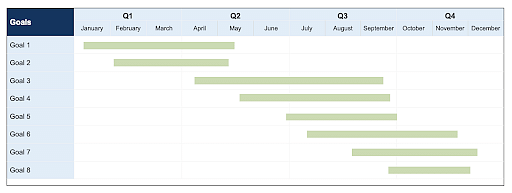
2. Portfolio Product Roadmap Template
Portfolio roadmaps display your scheduled releases for many products in a single view if you manage numerous products. It will provide a complete picture of progress and assist internal teams in understanding how their plans relate to one another.
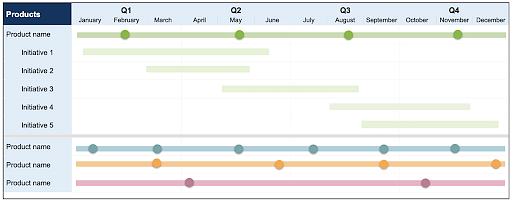
3. Product Release Roadmap Template
Product release roadmaps help outline the critical actions, such as stages and milestones, that must occur to provide your product update to clients. When you need to organize cross-functional release operations with engineering, marketing, sales, and customer support, this template comes in handy.
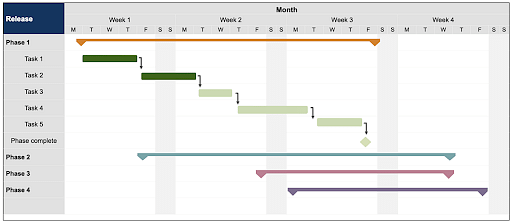
4. Product Feature Roadmap Template
A product feature roadmap outlines your timetable for introducing new features to clients. This template helps provide a higher degree of information than a release roadmap, such as individual feature statuses.
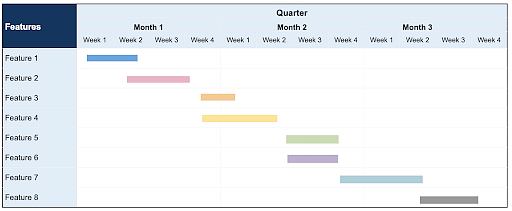
5. Agile Product Roadmap Template
Swimlanes in this agile product roadmap show how epics correlate with strategic themes. This roadmap view enables the engineering team to see how their daily work ties to the overall strategy.
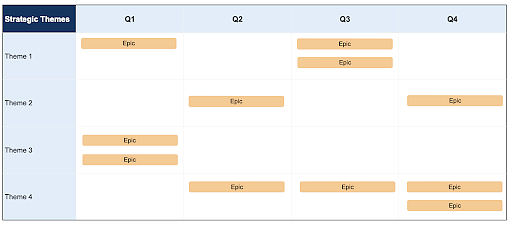
Product Roadmap Examples
Product roadmaps have different functions and uses depending on your organization and product, which means there are different types of product roadmaps you can create. The most common product roadmaps include:
The Portfolio Roadmap
This map shows your planned releases for various products all in a single view. It’s a useful format to use when showing executive, advisory boards, and internal teams the strategic overview of your map.
The Sprint Roadmap
A sprint roadmap is all about being delivery-focused for sprint planning. This means using sprint plans to help align development teams with their forthcoming work so that everything is up to date and on track. Sprints can be anywhere from a single week to a longer timeline, so a sprint roadmap takes the timeline given and plans it all out for optimal success.
The Releases Roadmap
This roadmap indicates what must happen before a release can be brought to market – i.e., what needs to be done, when it needs to be done, and who is responsible for that deliverable. This is extremely useful for collaboration between in-house cross-functional teams.
The Features Roadmap
This roadmap shows the overall timeline for when new features are to be delivered. It’s useful for communicating finer details to both internal teams and even customers.
Push the Boundaries of Team Productivity Today
Simplilearn’s Product Management Certification Training offers a comprehensive program to equip professionals with the essential skills and knowledge to excel in product management. The course covers vital topics like product lifecycle management, market research, product strategy, and user-centered design. With hands-on projects and real-world case studies, you'll gain the expertise to lead product development and innovation successfully. Perfect for aspiring product managers or professionals seeking to advance their careers, this course helps you drive impactful results in the ever-evolving field of product management.
You can also lead the future of innovation by combining your creativity with strategic thinking by enrolling in top-tier product management and design courses. Master the skills to create groundbreaking products and experiences that captivate users and drive business success. Whether you're aspiring to be a visionary designer or a product leader, now is the time to step up and shape your future with our programs. Explore and enroll today!
FAQS
1. What should a product roadmap include?
A product roadmap includes long and short term goals for the product or project, along with a plan to achieve it.
2. What are the stages of a product roadmap?
The three stages of research, strategic planning and organizational coordination.
3. What is a product roadmap in Agile?
Product roadmaps are required for agile teams to give direction and quantifiable goals. At the same time, there is lots of leeway in execution. The product roadmap, not the Agile process, provides the reason for what is getting created. It is critical to prioritize OKRs, KPIs, and themes over delivery timeframes and requirements.
4. Who prepares the product roadmap?
Finally, the product manager is in charge of the product roadmap. As a result, the product manager will be the driving force behind the roadmap planning.
